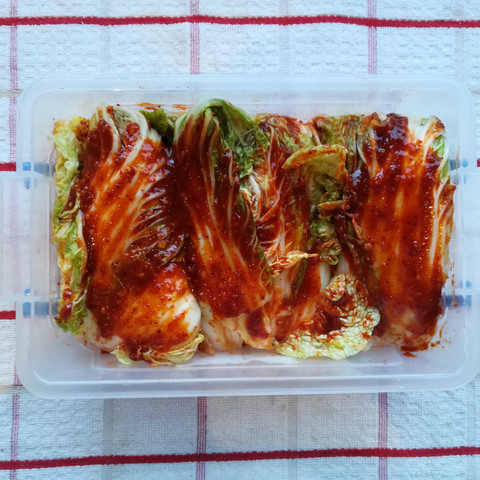Easy Kimchi Recipe
- lifeofandra

- May 6, 2020
- 3 min read
Updated: Oct 3

This traditional Korean dish has been part of my diet for many years now. I've tried all the recipes I could find, some successful, some failing big time and eventually I started playing with the quantities until I had a recipe that never failed me. I'm not claiming that this is a traditional Korean Kimchi recipe because it's not, it's just my take on it.
You will need:
For the prep phase:
1 cup of sea salt ( or any salt without iodine), half of it mixed with 2 cups of water
For the paste:
1 napa cabbage
10 tsp of red pepper paste (Gochujang)
2 tsp red pepper flakes (Gochugaru)
4 tsp sugar
4 tsp fish sauce
2-3 tsp sesame seeds (optional)
2-3 tsp crushed and diced garlic*
2-3 tsp grated peeled fresh ginger
2-3 scallions, diced
1 small daikon radish, cut into matchsticks
1 Korean/Nashi pear cut into matchsticks,
2 tbsp rice flour mixed with water 1/2 cup water
(optional) 2-3 tsp salted shrimp
Most original recipes - or the usual ones you will find online will have shrimp paste but I've made kimchi without it and I've been successful so far.
How to:
1. Cut the cabbage lengthwise in 4.
2. Sprinkle salt in between each layer and massage it gently in the leaves until the cabbage softens.
3. Place all 4 pieces in a bowl and then cover everything with salt water.
4. Let it be for about two hours then rinse it thoroughly and drain it. I normally rinse it about three or four times and then leave it in a colander to drain for 10-15 minutes at least. **
5. Mix the rice flour with the water and simmer over low heat until the mixture thickens, transfer it to a bowl and let it cool.
6. Once the rice mixture has cooled down, add the rest of the paste ingredients in a bowl and mix. Now comes the fun part. Make sure you wear gloves, trust me on this one (unless you're getting ready for a Halloween party and need to have bloody-red hands - this helps).
7. Take about a tablespoon of the mixture and spread it on each leaf. Once you're done with a quarter, roll it inward and place it in a glass or plastic (BPA-free) container.
When you're done with all four parts, push them gently to remove any air bubbles then put what's left of the mixture, then put the lid on.
I usually leave it at room temperature for at least a day, then transfer it to the fridge. For all the flavours to fully come out you should leave it in the fridge to ferment for at least one or two (preferably) weeks. My problem is I like kimchi too much to leave it alone for that long.

Notes:
*I say 2-3 tbs or pieces for some of the ingredients because it depends on how big the cabbage is and how much flavour you want. I would usually put more than less because I'm trying to avoid the situation where you still have a few leaves to cover and you run out of the mixture. Been there before, don't wanna go there again. You end up in the middle of the kitchen with a half-covered bit of cabbage in your hand, covered somewhat in red pepper paste and asking yourself the excellent question: 'Now what?'. Now, you make a tiny bit more of the mixture above, but have to juggle with the measures and then you promise yourself you'll measure better next time.
**Feel free to watch your favourite show while waiting for the cabbage to take its time in the salt bath. If you happen to watch 3 episodes instead of 2, the cabbage won't mind too much and you might finally be up to date with your favourite series.

So far I have tried this recipe with cucumbers, carrots, apples, celery sticks, and radishes (all chopped finely or cut into matchsticks) and I probably won't stop at these.
Give it a try and if you want to, let me know how it went. I'm curious
I hope life is treating you well.
Take care.

















